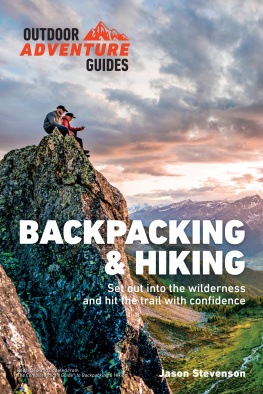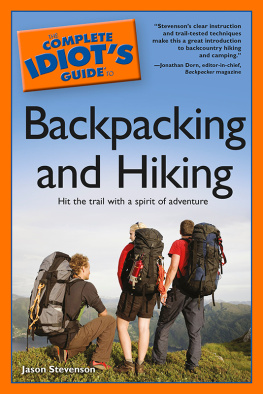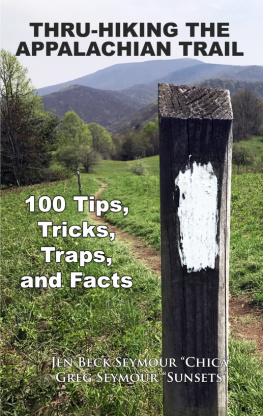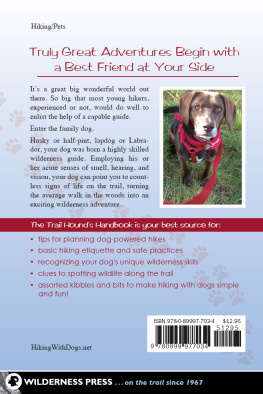JEN SOTOLONGO lives in Oregon with her dog, Sitka, a rescued red heeler mix. Theyre up for just about any outdoor activity, as long as they can do it together. More often than not, theyre on a trail run in the mountains. Jen is the author of the blog longhaultrekkers.com, a source for adventure dog parents to get outdoors and travel with their dogs. You can follow Jen and Sitka on Instagram @longhaultrekkers.
TO MY EDITOR, KATIE ODELL, who somehow found me on social media and reached out asking if I would be interested in writing a book about hiking with dogs. I missed her first email and, thankfully, she followed up. Thank you for believing that I was the right person to write this book.
To my unofficial editors, Jenna Hlady and my dog trainer, Ruben Montes. Thank you both for jumping without hesitation on my last-minute request to go over the dog behavior and training sections of this book. You provided important notes and guidance for these sections, and I thank you for your honesty and the time spent helping me out where I was stuck.
To my parents, who have always supported my adventures and my dreams, no matter how seemingly crazy and far away they may be, and who have often followed my dog and me around the world (lucky them!). Thank you for welcoming my dogs and me into your home when Im in between adventures.
To my contributors: Amanda Davis, Dawn Mellon, Joanna Lee, Amber Pitcher, Jane Patten, Katherine Taylor, Rory Riley Topping, Jessica Williams, and Hannah Zululeta. I am beyond grateful for your contributions to this book, for sharing your experiences and expertise, and for being exemplary members of the dog community. I met every single one of you on Instagram and have had the pleasure of meeting many of you and your dogs in person. I hope to do the same with those of you I have yet to meet.
To all my blog readers, friends, and my beloved Instagram community: I would not be writing this book if it were not for your devotion and interest in what I have to say about dogs. I started Long Haul Trekkers to document our bicycle tour, and it evolved into an incredible network that has provided invaluable information, inspiration, and friendship since 2015. I had no idea that I would develop such a wonderful community and build a career just by posting photos of and writing about my dogs.
And finally, to Sitka, my handsome little fox who will never read this, because he is a dog. Thank you for being up for all my adventures and for trusting me to lead you through the life we share together. I have plenty of shenanigans planned for us, Sweet Boy.
CONTRIBUTED BY KATHERINE TAYLOR
HIKING WITH YOUR DOG CAN BE as simple as grabbing any leash, collar, and water bowl (dont forget the poop bags!), but more specialized gear can make it more enjoyable, and safer to venture out a little farther.
LEASHES
There are plenty of innovative designs that can make your hike easier:
- If you hike in wet or muddy conditions, coated biothane webbing cleans up easily.
- For on-leash hikes, consider a hands-free waist leash. Some come with adjustability or built-in elastic for comfort. Euro leads (with a snap on each end) offer multiple configurations including waist leash and ability to walk two dogs. If youll be running, take a look at skijoring and canicross belts for better support and comfort.
- When hiking in an off-leash area, a short, waist-sized leash (like the Ruffwear Ridgeline or a custom leash) can be convenient since it can be worn as a belt when not in use.
- A traffic tab clipped to the harness or a collar leash like the Ruffwear Quick Draw or Rad Dog Release N Run makes your medium to large off-leash dog easier to grab at quick notice (these are too big for small dogs).
HARNESSES
Look for a comfortable fit that doesnt shift around or chafe between the front legs or behind the armpits. Avoid harnesses with a band that cuts horizontally across the shoulders in front (this limits range of motion), and make sure there is plenty of clearance for the neck and throat. Ill-fitting harnesses will fit either too loosely or too tightly and will not stay in place. You want to be able to insert two fingers between the straps and your dogs body.
Any well-fitting harness will work, but there are a couple of specialty options for more serious hiking:
- Sturdy assistance harnesses feature a handle at the middle of the back and are great for helping dogs over obstacles. These harnesses usually have two belly straps and cover a lot of the body. The Ruffwear Webmaster is a popular option; Hurtta makes its Trail Harness, and Groundbird Gear makes custom-fit breathable harnesses with full belly support (with optional backpacks).
- For backpacking or longer hikes, healthy dogs can wear backpacks to help carry their own snacks and essentials. Look for a backpack that fits close to the body, balances well, and has an appropriate capacity for your dogs build. Be sure to weigh out gear for your dogs safety.
WATER BOWLS
Anything will work (even your cupped palm if your dog is willing), but there are a few unique options:
- If youll be feeding your dog on the trail, screw-top silicone bowls can carry the food in and keep your pack clean on the way out. I like the Sea to Summit X-Seal line.
- If youre trail running or packing light, a super packable fabric bowl is the way to go. I find I offer water more often if the bowl is handy in my pocket. I use the Ruffwear Trail Runner, and Ive heard good things about the Rad Dog and Wildebeest Montara bowls.
Any time youre venturing farther from civilization, make sure to bring a first-aid kit with necessities for your dog as well as yourself. Look for a compact design with just the items you need and a lightweight, functional case, or youll find yourself leaving it at home.
DOG BOOTIES
For rough terrain, snow, ice, or in case of injury, consider carrying a set of dog boots. Pawz balloon boots are a good emergency option that packs small, but they dont last long. For small dogs, flexible fabric booties tend to work better than anything with a sole, since they allow small paws to grip the ground through the boot. For larger dogs, rubber-soled boots will last longer but take more getting used to, so prep ahead of time! Snug-fitting socks or boot liners underneath can help prevent blisters and chafing on short-haired dogs.
I LIKE TO KEEP BINS DEDICATED TO CAMPING GEAR and dog gear ready to transfer to the car on a moments notice. It means that I tend to forget fewer essentials and I can just up and go on a whim. Of course, there will be seasonal and food needs that you have to consider. I bring different gear for car camping versus backpacking, but much of it is the same. The lists below should serve as a guide for your own adventures. Youll learn what your own essentials are the more you hit the trails.
Winter Hiking
DOG
- Rain jacket
- Water
- Collapsible bowl
- Dog treat pouch
- Treats
- First-aid kit
- Dog goggles
- Winter jacket
- Booties
- Paw wax
- Towel (for car)
- Poop bags
HUMAN
- Headlamp
- Gloves
- Snowshoes or microspikes
- Gaiters or snow pants
- Beanie
- Merino wool baselayer
- Puffy coat
- Sunglasses
- Merino wool socks
- Fully charged phone
- Printed or offline map
- Waterproof hiking boots






